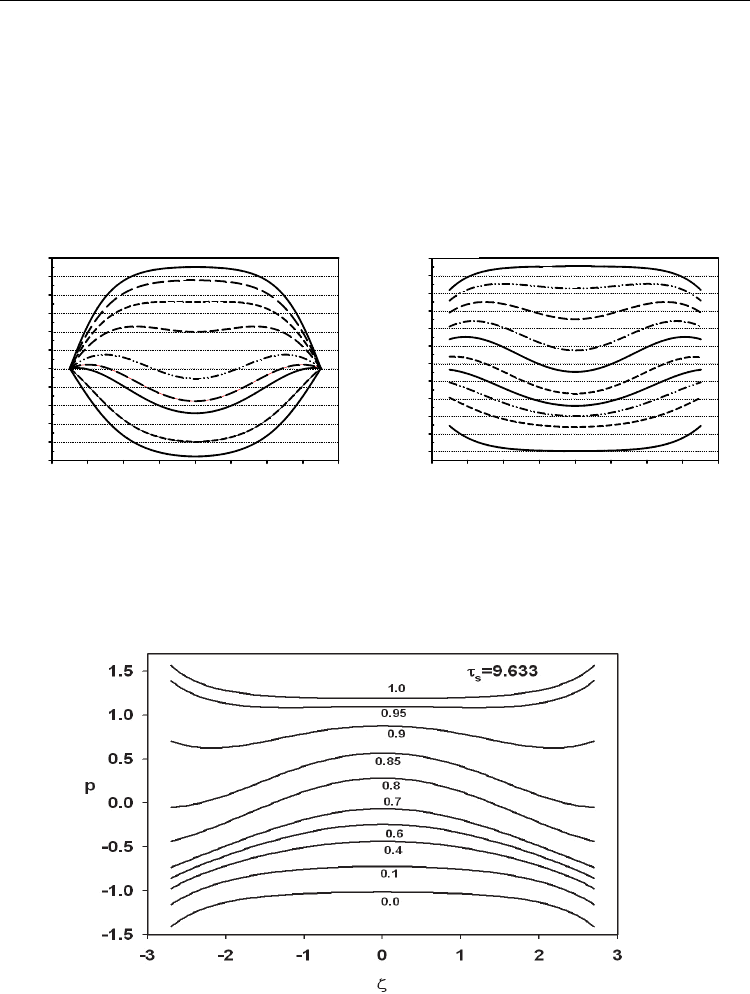Lallart M. Ferroelectrics: Characterization and Modeling
Подождите немного. Документ загружается.

18
Switching Properties of
Finite-Sized Ferroelectrics
L.-H. Ong
1
and K.-H. Chew
2
1
School of Physics, Universiti Sains Malaysia, Minden, Penang,
2
Department of Physics, University of Malaya, Kuala Lumpur,
Malaysia
1. Introduction
The characteristic property of ferroelectric materials, which is the reversal of polarization by
an external electric field, is of technological importance in device applications, particularly
in nonvolatile ferroelectric random access memories (NV-FeRAMs). These binary coded
NV-FeRAMs can be fabricated by using ferroelectric materials in which the polarization
direction can be switched between two stable states when a minimum electric field is
applied. To fabricate good quality NV-FeRAMs to meet the demands of the current market,
the ability to achieve low coercive field
c
E (the minimum external field required to reverse
the direction of remnant polarization), short switching time
s
t and high packing density
(Scott, 2000; Dawber et al., 2005) in the memory chips are great challenges. These
challenging factors are closely knitted with the underlying physics on the switching
properties of ferroelectric materials. Though the subject of interest has been elucidated both
theoretically and experimentally over the past sixty years and the achievements are
enormous, but the challenging factors mentioned are still current. Auciello, Scott and
Ramesh (1998) have explicitly outlined four main problems in NV-FeRAMs fabrication
which are related to basic physics. Firstly, what is the ultimate polarization switching
speed? Secondly, what is the thinnest ferroelectric layer which sustains stable polarization?
Thirdly, how do switching parameters, such as coercive field, depend on frequency? Lastly,
how small can a ferroelectric capacitor be and still maintain in ferroelectric phase? These are
fundamental problems which should be tackled through continuous experimental and
theoretical efforts.
From the theoretical perspective on this area of studies, a few models (Duiker and Beale,
1990; Orihara et al., 1994; Hashimoto et al., 1994; Shur et al., 1998) were proposed to study the
switching properties of ferroelectric thin film based on the Kolmogorov-Avrami theory of
crystallization kinetics (Avrami, 1939, 1940 and 1941). In these models, the authors focused
on statistics of domain coalescence. Tagantsev et al. (2002) proposed another model based on
the experimental work of a few groups (Lohse et al. 2001; Colla et al., 1998a; Ganpule et al.,
2000). Their model also focuses on statistics of domains nucleation. Another approach,
which is different from the classical nucleation reversal mechanism, is based on the Landau-
type-free energy for inhomogeneous ferroelectric system as discrete lattices of electric

Ferroelectrics - Characterization and Modeling
350
dipoles (Ishibashi, 1990). However, all these models neglect the surface effect, which is
shown to have influence on phase transitions of ferroelectric films, and as the films get
thinner the surface effect becomes more significant.
The continuum Landau free energy for a ferroelectric film, extended by Tilley and Zeks
(Tilley and Zeks, 1984), incorporates the surface parameter
δ
(extrapolation length). Positive
δ
models a decrease in local polarization at surface, and negative
δ
an increase, with a
smaller absolute value of
δ
giving a stronger surface effect. This model has been used to
elucidate phase transition and dielectric properties of FE thin films with great success
(Wang C. L. et al., 1993; Zhong et al., 1994; Wang Y. G. et al., 1994; Wang C. L. and Smith,
1995; Ishibashi et al., 1998; Tan et al., 2000; Ong et al., 2001; Ishibashi et al., 2007) and the
results of phase transition and dielectric properties of ferroelectric thin films obtained are
well accepted. In this chapter, we outline the progress of theoretical and experimental work
on switching phenomena of ferroelectric thin films, and the main focus is on the results of
switching properties of ferroelectric thin film obtained from the Tilley – Zeks continuum
Landau free energy and Landau-Khalatnikov (LK) dynamic equation (Ahmad et al., 2009;
Ong and Ahmad, 2009; Ahmad and Ong, 2009; 2011a; 2011b). The surface effects,
represented by
±
δ
, on properties of polarization reversal, namely, coercive field
c
E and
switching time
s
t
will be discussed (Ahmad et al., 2009). For positive
δ
,
c
E
and
S
t
decrease
with decreasing
δ
while for negative
δ
,
c
E and
s
t increase with decreasing
δ
. Strong
surface effects represented by smaller
δ
are more profound in thin ferroelectric films. As
the film size increases, the delay in switching at the centre relative to switching near the
edges is more remarkable for systems of zero or small polarization at the edges ( 0
δ
≅ ). It is
found that the dipole moments at the centre and near the edges switch almost together in
small-sized systems of any magnitudes of δ. (Ong et al., 2008a; 2008b). We also elucidated
the phenomena of polarization reversal of second-order ferroelectric films, particularly the
characteristics of hysteresis loops by an applied sinusoidal field. It is shown that at a
constant temperature, the size of hysteresis loops increases with increasing film thickness
for δ > 0 and the reverse is true for δ < 0. For a film of fixed thickness, the size of hysteresis
loop decreases with increasing temperature for cases of δ > 0 and δ < 0. We have
demonstrated that the effect of magnitude of the applied field on the hysteresis loops is
similar to the experimental results (Ong and Ahmad, 2009). Our numerical data also show
that switching time
S
t is an exponential function of the applied field and the function
implies that there is a definite coercive field in switching for various thicknesses of FE films
(Ahmad and Ong, 2011b). Lastly, since in reality, ferroelectric thin films are fabricated on
conductive materials (such as SrRuO
3
) as electrodes, hence, we shall include the effects of
misfit strain on switching phenomenon of epitaxial film of
3
BaTiO
(Ahmad and Ong,
2010a) and conclude with some remarks.
2. Ferroelectric thin film and Tilley-Zeks model
The behaviour of ferroelectric thin films is significantly different from that of the bulk. The
arrangement of atoms or molecules at the surface is different from that of the bulk material.
Due to the process of surface assuming a different structure than that of the bulk, which is
known as surface reconstruction, polarization at the surface is not the same as that in the
bulk; and it affects the properties of the material. This so called surface effect may have little
influence on the properties of material if the material is thick enough. However, when the

Switching Properties of Finite-Sized Ferroelectrics
351
material becomes thinner, the surface effect becomes significant. The demand by current
technological applicants on material thickness of ferroelectric thin film is now in the range of
nano-scale. Hence, surface effect in ferroelectric thin film is a significant phenomenon and
how it can affect switching must be understood.
The Landau free energy for a ferroelectric film, extended by Tilley and Zeks (Tilley and
Zeks, 1984), incorporates the surface parameter
δ
(also named the extrapolation length) and
for convenient, we named it TZ model. Positive
δ
models a decrease in local polarization at
the surface, and negative
δ
an increase; with a smaller absolute value of
δ
giving a stronger
surface effect. This is important since both forms of behavior have been observed in
experiments on different materials. With this surface parameter
δ
, the inherent material
properties at the surfaces of a ferroelectric film which can be either of the two cases are
explained. This Landau free energy is given by
()
2
/2
24 22
2
22
2
4
/2
00
0
0
L
dP
F
PP dz PP
dz
S
L
αβκ
κ
εε
εδ
ε
=++ ++
+−
−
, (1)
where S is the area of the film with plane surfaces at
=± /2zL
and
()
/2PPL
±
=± .
α
is
temperature dependent, taken in the form
00
()
C
TT
αα
=− with
0C
T the critical temperature of
the bulk material and the constants
0
α
, β and κ are positive.
0
ε
is the dielectric permittivity of
the material and the κ term inside the integral in Eq. (1), represents the additional free energy
due to spatial variation of P. Whereas the κ term outside the integral in Eq. (1), represents the
free energy due to the surface ordering.
3. Phase transition in ferroelectric thin film
We (Ong et al., 2000; 2001) reinvestigated the TZ model and obtained much simpler
expressions, compared with previous work (Tilley and Zeks, 1984), for the polarization
profiles of ferroelectric thin films in Jacobian elliptic functions for both positive and negative
δ
. Variation of Eq. (1) about the equilibrium form P(z) shows that this satisfies the Euler-
Lagrange equation (Ong et al., 2001)
2
3
22
00
0
0
dP
PP
dz
αβ κ
εε
ε
+− =
, (2)
with the following boundary conditions:
at /2
dP P
zL
dz
δ
=± =±
. (3)
It follows from Eq. (3) that if the extrapolation length
δ
is positive, P(z) decreases near the
surface, and if it is negative, P(z) increases. In consequence, the critical temperature
C
T of
the film is reduced below
0C
T for positive
δ
and increased for negative
δ
. The first
integration of Eq. (2) leads to
1
1
2
2
42
2
0
0
12 4
2
dP G
PP
dz
βα
κεββ
ε
=± + +
, (4)

Ferroelectrics - Characterization and Modeling
352
where G is the constant of integration. The extremum of P(z) is at z = 0 so that the central
value P(0) is a solution of the quadratic equation corresponding to dP/dz = 0:
()()
2
42 2222
00
12
24
0
G
P P pppp
εα ε
ββ
+ + =− −=, (5)
where the roots
1
P
and
2
P
are introduced for later use; and the roots are such that
22
21
PP> .
It follows from Eq. (5) that the product
22
21
.PPhas the same sign as G and it will be seen that
while
2
2
P is always positive for both signs of
δ
, in the case of 0
δ
> , there is a temperature
interval in which G and therefore
2
1
P are negative.
The P integral resulting from Eq. (4) can be expressed by inverse elliptic functions so that
ultimately P(z) is expressed in terms of an elliptic function. The detailed forms depend on
the sign of
δ
.
In the case of 0
δ
> , it can be shown that
2
0
0/4G
αβ
<< so that,
2
1
P and
2
2
P are both
positive. Since positive
δ
leads to a decrease of P(z) at the surface of the film we have the
inequalities
12
0()Pz P P<<<. The central value P(0) is the maximum value of P(z) and is in
fact equal to
1
P . The expression for P(z) is
1
() ( / , )Pz PsnK z
ξ
λ
=−
, (6)
in standard notation for elliptic functions. The modulus λ is given by
12
/PP
λ
= ; ()KK
λ
=
is the complete elliptical modulus and the scale length
ξ
is
21/22
02
2/( )P
ξεκβ
=
. (7)
In the case of 0
δ
< , the analytical work is complicated because the expression for
polarization profile depends on temperature range. In the temperature interval
0 C
TTT≤≤
in which G < 0 and
222
12
0()PPPz≤≤ ≤
. In the interval where G is negative, P(z) takes the
form,
2
1
()
(/, )
P
Pz
cn z
ζ
λ
=
(8)
where
222
1121
/( )PPP
λ
=− − is the modulus, and the scaling length is given by
2
2
0
22
21
2
()PP
εκ
ζ
β
=
−
. (9)
While for the temperature interval
0
TT<
, the parameters satisfy the inequalities G > 0,
222
12
0()PPPz<<< 0, and the polarization profile is found to be
2
()
(/,)
P
Pz
sn K z
ξ
λ
=
−
. (10)
Similarly, the modulus λ is given by
12
/PP
λ
= ; ()KK
λ
= is the complete elliptical
modulus. These simpler analytical expressions, describing the polarization profile of a

Switching Properties of Finite-Sized Ferroelectrics
353
ferroelectric film with either positive or negative
δ
, are important in helping the study of
switching properties of ferroelectric film as well as size and surface effects on properties of
phase transition. In the case of negative
δ
, there is no size induced phase transition; but for
positive
δ
, we have found an expression for the minimum thickness
C
L of ferroelectric film
to maintain ferroelectric properties. This minimum thickness is a function of
δ
and
temperature T as shown below:
()
1
2tan
C
CC
LT
ξ
ξ
δ
−
=
. (11)
C
ξ
is the correlation length at critical temperature given by
00
/
CCC
TT
ξξ
=−and
0
ξ
is the
zero temperature of correlation length.
0
and
CC
TT are the critical temperatures of the film
and bulk, respectively. Eq. (11) provides hints to the experimentalists that minimum
thickness of ferroelectric film is dependent on the critical temperature, as well as
δ
; hence
these values are material dependent.
We have also presented new thermodynamic functions, the entropy and specific heat
capacity, for ferroelectric films with both cases of
δ
± . These thermodynamic functions
provide useful information that the phase transitions in both cases of
δ
± are stable (Ong et
al., 2001). The reports in the literature on the claims of possible surface state in the case of
negative
δ
(Tilley and Zeks, 1984) and film transition can be first order even if its bulk is
second order (Qu et al., 1997) had caught our attentions and after careful investigation, we
found that there is no surface state in the negative
δ
case and the film transition is always
second order as in the bulk transition.
4. Formalism for switching in ferroelectric thin films
Theoretical and experimental work on switching phenomena of bulk ferroelectric began
about half a century ago. The interest in this research area has further been extended to
ferroelectric thin films; and the interest has not waned even up to these days because of the
advancement in thin film fabrication technology, where higher quality and more reliable
ferroelectric thin films can be fabricated; thus making the applications of ferroelectric thin
films in microelectronic devices and memories (Uchida et al., 1977; Ganpule et al., 2000) more
reliable. Current theoretical and experimental researches in polarization reversal in
ferroelectric thin films are focused on phenomena related to effects of size and surface in
thin films on switching time and coercive field (Ishibashi and Orihara, 1992; Wang and
Smith, 1996; Chew et al., 2003).
From the literature, several theoretical models based on a Landau-typed phase transition
have given good explanations on switching behaviours of mesoscopic ferroelectric
structures (Ishibashi and Orihara, 1992; Wang and Smith, 1996); and some of the predictions
concerning size on switching behaviours by Landau-typed models agree well with
experimental observations. However, the detailed understanding of surface effect on
ferroelectric films under the applied electric field is still inadequate, but understanding of
surface effect is important for the overall understanding on the switching behaviours of
ferroelectric films. Thus, we extended the TZ model for ferroelectric thin films given in Eq.
(1) by adding in the energy expression a term due to electric field (–EP)

Ferroelectrics - Characterization and Modeling
354
()
2
/2
24 22
2
22
2
4
/2
00
0
0
L
dP
F
PP dz PP
dz
S
L
EP
αβκ
κ
εε
εδ
ε
=++ ++
+−
−
−
(12)
and minimization of Eq. (12) by variational method shows that the polarization satisfies the
Euler Lagrange (EL) equation
2
3
22
00
0
0
dP
PPE
dz
αβ κ
εε
ε
+−− =
, (13)
with the following boundary conditions:
at /2
dP P
zL
dz
δ
=± =±
. (14)
The Landau-Khalatnikov dynamic equation is used to study switching behaviours in
ferroelectric thin films (Ahmad et al., 2009; Ong et al., 2008a; 2008b; 2009; Ahmad and Ong,
2011b), and it is simplified to the form as follow:
2
3
00
22
00
0
()
(/)
C
TT
PFS dP
PP E
P
dz
α
δβκ
γ
τδ ε ε
ε
−
∂
=− =− − + +
∂
, (15)
where γ is the coefficient of viscosity which causes a delay in domain motion and
τ
is the
time. In this equation, the kinetic energy term
22
/mP
τ
∂∂ is ignored, since it only
contributes to phenomenon in the higher frequency range. The applied electric field E can
be a static step field or a dynamic field. We obtained the equilibrium polarization profile
()Pz from the elliptic function derived Eq. (1), and this profile is symmetric about the film
centre z = 0.0. The initial polarization profile of the ferroelectric film at e = 0.0 is obtained
from solving Eq. (4) for the elliptic functions derived by Ong et al. (2001). In all our
simulations, the initial polarization in the film is switched from its negative value. By
solving Eq. (15) using the Runge-Kutta integration by finite difference technique, we
obtained the reversal of polarization. The reversal of polarization is studied by applying a
stepped electric field and the hysteresis loops are obtained by sinusoidal field
respectively, as these fields are usually used in experiments. The applied stepped field is
of the form
0
()EEf
τ
= , (16)
where f (
τ
) is a usual step-function defined as
0
0
1 for 0
()
0 for
f
ττ
τ
τ
≤<
=
. (17)
0
τ
is the time taken when the field is switched off and
0
E is the maximum applied electric
field. The sinusoidal field in the reduced form is

Switching Properties of Finite-Sized Ferroelectrics
355
0
sin( )
r
ee
ωτ
= , (18)
where
0
e is the amplitude and
ω
is the angular frequency. The dimensionless formulations
used in the calculations are obtained by scaling Eqs. (12) to (16) according to the way discussed
in our articles. All parameters listed in the equations above are scaled to dimensionless
quantities. We let
0
/z
ζξ
= with
2
000
/
C
T
ξκα
= and
0
ξ
corresponds to the characteristic
length of the material. Normally,
0
ξ
is comparable to the thickness of a domain wall. l is the
dimensionless form of thickness L scaled to
0
ξ
. We have temperature T scaled as
0
/
C
tTT=
,
0
/
p
PP= with
2
00
/
C
PATB
ε
= and /
C
eEE= with
233
00 0
4/(27)
CC
ET
αε
β
= . The global order
parameter is the average polarization of the film defined as
()
/2
/2
1
l
l
p
pd
l
ζζ
−
=
. (19)
5. Polarization evolution in ferroelectric films
Surface condition due to
δ
and size of ferroelectric films affect the switching profiles of
ferroelectric films. A ferroelectric film with zero
δ
means the surface polarization is zero
at both surfaces of the film. When a positive electric field E is applied on ferroelectric
films with zero and non-zero
δ
, various stages of switching profiles are shown in Fig. 1
and Fig. 2, respectively, for temperature
0
0.6
C
TT= . The starting equilibrium polarization
profile is set at negative at time t = 0; and the profile is switched over to positive state by
the applied electric field E until it is completely saturated. In a thin ferroelectric film
(Fig. 1), switching at the surface and at the centre is almost the same irrespective of either
zero or non-zero
δ
.
Fig. 1. Polarization profiles during switching, at various time in term of fraction of the total
time
"
S
τ
to reversed the profile, at temperature
0
0.6
C
TT= , applied field 0.83
C
EE= , for
thickness
ζ
= 3.3: (a)
δ
= 0; (b)
δ
= 2.0. The number at each curve represents time taken to
reach the stage in term of fraction of
"
S
τ
. (Ong et al., 2008b)
For thick films, surface switching takes place relatively faster than the interior of the films
(Fig. 2); the reversal of polarization begins near the surfaces first, and then goes on to the
ζ
-2.0 -1.5 -1.0 -0.5 0.0 0.5 1.0 1.5 2.0
P
-0.4
-0.2
0.0
0.2
0.4
0.6
0.8
0.0
0.1
0.2
0.3
0.4
0.5
0.8
1.0
0.15
ζ
-2.0 -1.5 -1.0 -0.5 0.0 0.5 1.0 1.5 2.0
P
-1.0
-0.8
-0.6
-0.4
-0.2
0.0
0.2
0.4
0.6
0.8
1.0
1.2
0.0
0.1
0.3
0.6
0.7
0.75
0.8
0.85
0.9
1.0
(b)
(a)

Ferroelectrics - Characterization and Modeling
356
centre, as shown in Figs. 2(a) and (b). This indicates that the domain wall is formed near
the surfaces, followed by a domain wall movement towards the centre. Hence, when the
film becomes thicker, the delay in switching at the centre of the film is more distinct
compared with the delay nearer the film surfaces. In term of domain wall movement in
the film, it obviously takes a longer time for a domain wall to move from the surface to
the centre for a thick film than a thin film. However, the delay in switching at the centre
is more remarkable in the zero-
δ
film as the film thickness increases. (Ong et al., 2008a;
2008b).
Fig. 2. Polarization profiles during switching, at various time in term of fraction of the total
time
"
S
τ
to reversed the profile, at temperature
0
0.6
C
TT= , applied field 0.83
C
EE= ,
thickness
ζ
= 7.0 for (a)
δ
= 0; (b)
δ
= 2.0. The number at each curve represents time taken to
reach the stage in term of fraction of
"
S
τ
. (Ong et al., 2008b)
Fig. 3. Polarization profile during switching at various time in term of fraction of the total
time
"
S
τ
to reversed the profile, for film thickness
ζ
= 5.4, 2
δ
=− ,
1.50
C
EE=
, T = 0.0. The
number at each curve represents time taken to reach the stage in term of fraction of
"
S
τ
.
ζ
-4 -3 -2 -1 0 1 2 3 4
P
-1.0
-0.8
-0.6
-0.4
-0.2
0.0
0.2
0.4
0.6
0.8
1.0
1.2
0.0
0.1
0.5
0.6
0.9
1.0
0.85
0.8
0.7
ζ
-4 -3 -2 -1 0 1 2 3 4
P
-1.0
-0.8
-0.6
-0.4
-0.2
0.0
0.2
0.4
0.6
0.8
1.0
1.2
0.0
0.1
0.9
0.93
0.95
0.96
0.97
0.98
1.0
0.8
(
a
)
(
b
)

Switching Properties of Finite-Sized Ferroelectrics
357
The general trend in polarization reversal of a film, irrespective of value of
,
δ
shows clearly
that total time
"
S
τ
to reverse the profile is longer as the film gets thicker. In the case of
negative
δ
for thick film, switching of dipole moments at the film centre takes place before
that at the film surface, which is obviously shown in Fig. 3. This phenomenon is contrary to
what we observed in a ferroelectric film with positive
δ
(Fig. 1 and Fig. 2); that is switching
happens at surface before the film centre. For a ferroelectric film with negative
δ
, the
polarization at the surfaces are greater than that at the centre.
6. Coercive field and switching time in ferroelectric films
The basic understanding of properties of thickness and surface dependence of switching
time and coercive field in switching of ferroelectric materials is of great importance to the
application of FE thin-films in non-volatile memories, for example the ferroelectric random
access memory (FERAM). From the results of earlier work on switching behaviour of single
crystal barium titanate (BaTiO3) (Merz, 1954; 1956; Miller and Savage, 1958; Stadler, 1958;
Fatuzzo, 1962), a few empirical formulations which illustrate the dependence of switching
time on applied electric field in switching of ferroelectric crystals are cited. For instant, in
1954 Merz reported that switching time
S
τ
is proportional to −1/( )
C
EE where E is an
applied electric field and
C
E
is the coercive field strength. A couple of years later, Merz
(1956) showed that switching time
S
τ
versus applied electric field E for low electric field
(<10 kV/cm) in single crystal BaTiO
3
is an exponential function
exp( / )
S
E
ττ α
∞
=
, where
τ
∞
is the switching time for an infinite field strength and
α
is the activation field. This
empirical formulation does not imply a definite coercive field in the switching of a single
crystal BaTiO
3
.
A similar empirical formulation for domain wall velocity as an exponential function of
applied electric field E was proposed by Miller and Savage (1958); and their formulation
also does not imply a definite coercive field in the switching of ferroelectric crystals. From
their formulations, we can deduced that when an electric field E, however small is applied
to a sample, it is just a matter of time; the dipole moments in the sample will ultimately be
switched. Around the same period of time, Stadler (1958) extended Merz’s work on a single
crystal BaTiO
3
for high applied field, ranging from 10 kV/cm to 100 kV/cm; and he found
that switching time
S
τ
is related to an applied electric field E according to a power law:
n
S
kE
τ
−
= , where k is a constant and n is equal to about 1.5. Later, Fatuzzo (1962) proposed a
combination of the power law and the exponential relation between switching time
and applied electric field in his analytical calculations based on the assumption of sideway
movement of the domain wall. Again, this new formulation shows that there
is no definite coercive field in the switching of FE materials. Lately, Kliem and Tadros-
Morgane
(2005) have shown that their experimental data on extrinsic switching time
ex
τ
(time taken when the polarization has reached 90% of its maximum value) versus applied
electric field E for various thicknesses of ultra-thin PVDF Langmuir-Blodgett
films do not fit the formula
exp( / )
S
E
ττ α
∞
= or the intrinsic switching formula
11
22
010
1/ ( / 1) [1 ( )/( )]
in C
EE TT T T
τ
=−−− − derived by Vizdrik et al. (2003). In the later
formula,
in
t
is the switching time,
0
T
is the phase transition temperature and
3
10
3/(4)TT B A
γ
=+
, where B, γ and A are the Landau parameters. This formula indicates

Ferroelectrics - Characterization and Modeling
358
that there is a definite coercive field for PVDF material in the intrinsic homogeneous
switching. Finally Kliem and Tadros-Morgane (2005) showed a best fit of their experimental
data by a formulation
0
exp( / )
ex ex C
EE
ττ η
=− with
0ex
τ
and η depending on sample
thickness and
C
E
, the coercive field obtained from the hysteresis loop.
On the other hand, evidence of a definite coercive field in the switching of FE materials are
reported from experimental results, for example in sodium nobate (NaNbO
3
) (Pulvari, 1960;
. Miller et al., 1962). Another example is from Fousek and Brezina
(1960; 1964), who reported
that when the applied voltage on BaTiO
3
is below a certain threshold value, no domain wall
movement has been observed; but when the applied field is above a threshold field, domain
wall movement is detected to be out of phase with the applied voltage. Further more, Fang
and Fatuzzo (1962) also reported the occurrence of coercive field on bismuth titanate
(Bi
4
TiO
12
). In later measurements on good single crystals by Pulvari (1962, 1964 cited in
Fatuzzo and Merz, 1967) also indicated there was definite coercive field in the switching and
it was confirmed by Cummins (1965). More recent evidence of definite coercive field
observed experimentally was reported in the switching kinetics of ferroelectric Langmuir-
Blodgett films of 70% vinylidenefluoride and 30% trifluoroethylene copolymer with
thickness up to 15 nm (Vizdrik et al., 2003).
There are a couple of theoretical models proposed to study the switching behaviours of FE
films; the Kolmogorov-Avrami-Ishibashi theory (Ishibashi and Orihara, 1992a; 1992b;
Ishibashi, 1993) which is originated from a model of crystal growth (Kolmogorov, 1937;
Avrami, 1939, 1940, 1941) and the Landau-typed model (Ishibashi, 1990; 1992; Wang and
Smith, 1996). In the later model, one of the authors (Ishibashi, 1992) fitted his numerical
data by the formula
exp( / )
S
E
ττ α
∞
= . While the other authors (Ishibashi, 1990; Nagaya
and Ishibashi, 1991) fitted their numerical data by the empirical formulations of Merz (1954,
1956)
and Stadler (1958) mentioned above. However, they have not mentioned which
formulation gives the best fit. With these developments in the area of research in switching
phenomena of FE materials especially in FE thin films, we are motivated to use Landau
Devonshire (L-D) free energy of a FE film proposed by Tilley and Zeks (T-Z) (1984) and
Landau Khalatnikov equation of motion to look into the dependence of switching time on
applied electric field. We have also investigated the effects of thickness on coercive field
and switching time and made comparisons with some experimental findings. From the
literature, some experimental results (Hase and Shiosaki, 1991; Fujisawa et al., 1999) show
that coercive field increases with decreasing film thickness while others (Wang et al., 2002;
Yanase et al., 1999) claim the reversed; and these contradictions are explained by the effects
of negative and positive values of extrapolation length,
δ
in the TZ model (Tilley and Zeks,
1984; Ong et al., 2001; Ahmad and Ong, 2009).
There are several definitions of switching time in the literature (Fatuzzo and Merz, 1967;
Ishibashi, 1990; 1992; Nagaya and Ishibashi, 1991; Omura and Ishibashi, 1992; Katayama et
al., 1993); however, in our case, the switching time
S
τ
is taken as the time taken when the
current has reached 10% of its maximum value (Ahmad and Ong, 2009, Omura and
Ishibashi, 1992; Katayama et al., 1993) similar to what we have done in our previous work
32
.
The variation of switching time
S
τ
in a film of thickness l = 2.0 and extrapolation length
3.0
δ
= at temperature t = 0.0, with applied field e is shown in Fig. 4. The triangular markers
indicated in Fig. 4 represent the numerical data obtained from our calculations.
To investigate whether coercive field truly exists in ferroelectric thin films, curves based on
